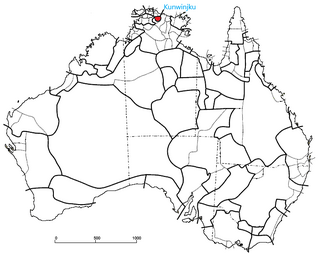
The Kunwinjku people are an Australian Aboriginal people, one of several groups within the Bininj people, who live around West Arnhem Land to the east of Darwin, Northern Territory. Kunwinjku people generally refer to themselves as "Bininj" in much the same way that Yolŋu people refer to themselves as "Yolŋu".
The Maraura or Marrawarra people are an Aboriginal group whose traditional lands are located in Far West New South Wales and South Australia, Australia.
The Bininj are an Aboriginal Australian people of Western Arnhem land in the Northern Territory. The sub-groups of Bininj are sometimes referred to by the various language dialects spoken in the region, that is, the group of dialects known as Bininj Kunwok; so the people may be named the Kunwinjku, Kuninjku, Kundjeyhmi (Gundjeihmi), Manyallaluk Mayali, Kundedjnjenghmi and Kune groups.
The Jarildekald (Yarilde) are an indigenous Australian people of South Australia originating on the eastern side of Lake Alexandrina and the Murray River.
Keiadjara, also rendered Kiyajarra, were an Aboriginal Australian people of the Pilbara region of Western Australia.
The Gadjalivia were an indigenous Australian people of Arnhem Land in the Northern Territory. They are now regarded as extinct.
The Jaako (Yaako) were an indigenous Australian people of the Northern Territory.
The Oitbi were an indigenous Australian people of the Cobourg Peninsula of the Northern Territory.
The Wurango or Wurrugu are an indigenous Australian people of the Northern Territory.
The Djalakuru were an indigenous Australian people of the Northern Territory.
The Jamindjung, also spelt Djamindjung, are an indigenous Australian people of the Northern Territory.
The Ngaliwurru are an indigenous Australian people of the Northern Territory.
The Wirngir are an Aboriginal Australian people of the Kimberley region of Western Australia.
The Antakirinja, otherwise spelt Antakarinya, and alternatively spoken of as the Ngonde, are an indigenous Australian people of South Australia.
The Gungorogone are an indigenous Australian people of the Northern Territory.
The Ngardok were an indigenous Australian people of the Northern Territory. Nothing is known of the language, which has been extinct since about WW2.
The Iwaidja are an indigenous Australian people of the Northern Territory.
The Yunggor were an Aboriginal Australian people of the Northern Territory.
The Limilngan, also known by the exonym Minitja and Buneidja, are an Aboriginal Australian people of the Northern Territory. Earlier ethnologists such as Norman Tindale referred to the group as Puneitja or variants of that spelling.
The Wandjira were an indigenous Australian people of the Northern Territory.